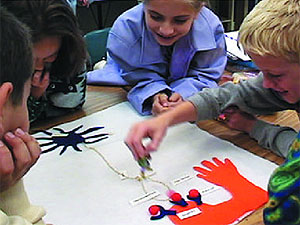|
General
Introduction
Grade 3 Introduction - The Brain &
Skull
- Lesson 1 - Animal Skulls - Students become
aware of the relationship between the skull and the brain,
and to begin thinking about how humans are both
alike and different from other mammals.
- Lesson 2 - Wonders of the Brain - Students
become aware that the human brain is an amazing organ. The
differences between human and animal brains are what allows us
to do these things.
- Lesson 3 - Clay Brains - Students learn
basic brain anatomy.
- Lesson 4 - Brain Trace - Students learn basic
brain anatomy and terms and become more aware of how the
brain's structures are situated in relation to one another.
- Lesson 5 - Brain Remembers - Students gain
a better grasp of brain anatomy through the use of notetaking.
- Lesson 6 - The Magic Wand - Students gain an
understanding that there is localization of function in
the human brain.
Grade 4 Introduction - Reaction
Time
- Lesson 1 - Catch a Ruler - Students are
introduced to neurotransmission in the context of a reaction time
experiment that demonstrates the concept of gravity and
the reaction of the nervous system.
- Lesson 2 - Quick Communication -
Students experience the
body reacting, while also increasing their awareness of
body systems in the context of the scientific method.
Grade 4 Introduction -
Neurotransmission
Grade 4 Introduction -
Nicotine
- Lesson 1 - Nicotine in the Body -
Students will understand how cigarette smoke travels through the
respiratory system and bloodstream to the brain.
- Lesson 2 - Nicotine in the Brain -
Students will understand the biological changes that take place in
neurotransmission in the presence of nicotine that lead to dependence
and addiction.
|
Grade 5 Introduction -
Sleep
- Lesson 1 - More to Discover -
Students are introduced to the topic of dreams, turning
students' attention to themselves and their body
processes as they begin to link dreaming to the brain.
- Lesson 2 - Frequency Counts -
Students are introduced to the concept that quantitative
descriptors describe things numerically and that electrical activity in
the brain corresponds to our state of consciousness.
- Lesson 3 - Quantify Your Dreams - Students
gain experience in graphing quantitative data and begin
to understand the cycling of electrical activity in the
brain during sleep.
- Lesson 4 - Musical Dreams - Students gain
experience in the scientific method with the collection and
interpretation of data, which they then use to make predictions or
hypotheses about the outcomes of future tests. They
also tie musical rhythms to body rhythms through a
mini-play.
- Lesson 5 - What Do We Know - Students play a
board game to review concepts related
to electrical energy in the brain and body.
The development of the Brain Explorers curriculum was funded by a Science
Education Drug Abuse Partnership grant (5 R25 DA11657-03) from the
National Institute on Drug Abuse,
National Institutes of Health.


|


![[email]](../gif/menue.gif)

